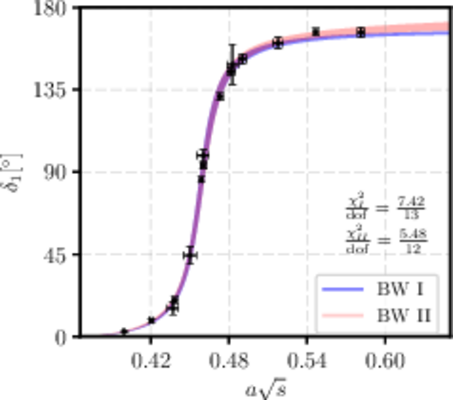ELEMENTARY PARTICLE PHYSICS
A Strong Side of Weak Decays: How Beauty and Charm Resonate in Pions and Kaons
Principal Investigator:
Marcus Petschlies
Affiliation:
Helmholtz-Institut für Strahlen- und Kernphysik, Rheinische Friedrichs-Wilhelms-Universität Bonn
Local Project ID:
pr27yo
HPC Platform used:
SuperMUC-NG at LRZ
Date published:

Figure 1: Illustration of the B-decay to a 2-pion state via the rho resonance
Introduction
The B and D mesons, which are built each form a pair of bottom and light or charm and light quarks, are among the more exotic particles observed in the realm of high energy physics. However, they play an eminent role in our present-day efforts to probe our understanding of the fundamental strong and electroweak forces in Nature, which we describe in the Standard Model of elementary particle physics. Both mesons are unstable under the electroweak interaction, and the transition amplitudes for their decays to states including two pions or a pion and a kaon ( denoted for brevity as e.g. and ) are an essential ingredient to the investigation of semileptonic B and D decays in the effective electroweak sector of the Standard Model. These flavor changing processes, involving transitions at the quark level of heavy bottom and charm quarks to lighter up and strange quarks (for short, e.g. and, plus leptons and neutrinos), are gold-plated candidates at the high-precision frontier for testing the Standard Model, as well as in the search for physics beyond the Standard Model: the transition pertains to the precision estimate of the element of the Cabibbo-Kobayashi-Maskawa (CKM) quark mixing matrix , a fundamental parameter of the Standard Model.
The flavor anomalies in observed as tensions between measured B-meson decays and their Standard Model prediction allow for exciting investigations of New Physics scenarios. The decay is illustrated in Figure 1. The transition matrix elements factorize in an electroweak part, and in one part that is governed by the strong interaction and determined numerically in pure Quantum Chromodynamics (QCD). The latter factor is pictorially defined by the blue box frame. Being subject to the strong force, the theoretical physics investigation of this process requires the High Performance Computing methods of Lattice QCD and thus the computational power of the supercomputer SuperMUC-NG.. Studying the process becomes even more challenging, when the elastic pion-pion scattering in the final state, which features the famous resonance is taken into account. (Or the andresonances for the transition.)
The rigorous calculation of such matrix elements with an unstable final state must include the proper conversion of our Lattice QCD data obtained in a finite box of size to the infinite volume of the physical world. Thus the study of and scattering in Lattice QCD forms an integral part of our computational project.

Figure 2: phase shift fit results for pion -pion P-wave at 320 MeV pion mass (top), kaon- pion S-wave (center) and P-wave (bottom) elastic scattering at 180 MeV and 320 MeV pion mass, determined from Lattice QCD [1,2]
Results and Methods
The major steps in our Lattice QCD calculation are spectroscopy and mapping to scattering amplitudes (1) for isospin I = 1 with focus on the P -wave ( resonance) channel and (2) for I = 1/2 with focus on S-wave ( resonance ) and P-wave (resonance). Step (3) is the production of 3-point correlation functions for B, D-meson and and initial and final states, and mapping of extracted matrix elements to infinite-volume amplitudes, based on items (1) and (2) with the Lellouch-Lüscher method and its generalization by Briceno, Hansen and Walker-Loud. The required Wick contractions to construct 2-point correlation functions and matrices thereof for variational analysis of the Lattice QCD spectrum are calculated based on SuperMUC-NG partitions with up to 2592 cores and approximately 25000 core-hours per job, and using the C/C++ QLUA software suite [3] and QOPQDP-multigrid solver for numerically solving the large sparse linear system of the Dirac equation. With the help of SuperMUC-NG resources we could investigate the and elastic scattering amplitudes for 2 values of the pion mass ( 320 MeV label “C13” and 180 MeV with label “D6”). The phase shifts (P-wave) and(S-wave) are shown in Fig. 2, with ample details about their practical computation given in Refs. [1,2].
Ongoing Research/Outlook
With pion-pion and kaon-pion scattering amplitude information in hand, we simulate the beauty and charm meson 3-point functions for the transitions BD→ππKπ and extract the infinite-volume matrix elements in analogy to the case of πγ*→ππin [4]. In the near future, the resources of SuperMUC-NG allow us to continue our simulation ever closer to the conditions of the physical world, including lighter pions, larger lattice volume, smaller lattice discretization, and to probe such intricate effects as coupled decay channels (mixing of 2-kaon and 2-pion states, and of kaon-pion and kaon-eta states), towards a rigorous contact with experment.
References and Links
[1] C. Alexandrou, L. Leskovec, S. Meinel, J. Negele, S. Paul, M. Petschlies, A. Pochinsky, G. Rendon and S. Syritsyn, Phys. Rev. D 96 (2017) no.3, 034525
[2] G. Rendon, L. Leskovec, S. Meinel, J. Negele, S. Paul, M. Petschlies, A. Pochinsky, G. Silvi and S. Syritsyn, Phys.Rev.D 102 (2020) 11, 114520
[3] USQCD software Qlua package,
https://usqcd.lns.mit.edu/w/index.php/QLUA
[4] C. Alexandrou, L. Leskovec, S. Meinel, J. Negele, S. Paul, M. Petschlies, A. Pochinsky, G. Rendon and S. Syritsyn, Phys. Rev. D 98 (2018) no.7, 074502
Science Contact
Dr. Marcus Petschlies
Rheinische Friedrich-Wilhelms-Universität Bonn
Helmholtz-Institut für Strahlen- und Kernphysik
Nußallee 14-16
53115 Bonn
E-Mail marcus.petschlies@hiskp.uni-bonn.de